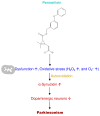Behavioral Tests in Neurotoxin-Induced Animal Models of Parkinson's Disease
- PMID: 33081318
- PMCID: PMC7602991
- DOI: 10.3390/antiox9101007
Behavioral Tests in Neurotoxin-Induced Animal Models of Parkinson's Disease
Abstract
Currently, neurodegenerative diseases are a major cause of disability around the world. Parkinson's disease (PD) is the second-leading cause of neurodegenerative disorder after Alzheimer's disease. In PD, continuous loss of dopaminergic neurons in the substantia nigra causes dopamine depletion in the striatum, promotes the primary motor symptoms of resting tremor, bradykinesia, muscle rigidity, and postural instability. The risk factors of PD comprise environmental toxins, drugs, pesticides, brain microtrauma, focal cerebrovascular injury, aging, and hereditary defects. The pathologic features of PD include impaired protein homeostasis, mitochondrial dysfunction, nitric oxide, and neuroinflammation, but the interaction of these factors contributing to PD is not fully understood. In neurotoxin-induced PD models, neurotoxins, for instance, 6-hydroxydopamine (6-OHDA), 1-Methyl-4-phenyl-1,2,3,6-tetrahydropyridine (MPTP), 1-Methyl-4-phenylpyridinium (MPP+), paraquat, rotenone, and permethrin mainly impair the mitochondrial respiratory chain, activate microglia, and generate reactive oxygen species to induce autooxidation and dopaminergic neuronal apoptosis. Since no current treatment can cure PD, using a suitable PD animal model to evaluate PD motor symptoms' treatment efficacy and identify therapeutic targets and drugs are still needed. Hence, the present review focuses on the latest scientific developments in different neurotoxin-induced PD animal models with their mechanisms of pathogenesis and evaluation methods of PD motor symptoms.
Keywords: 6-OHDA; MPP+; MPTP; Parkinson’s disease; animal behavioral studies; motor symptoms; neurotoxins; paraquat; permethrin; rotenone.
Conflict of interest statement
The authors have no financial disclosures or conflicts of interest to declare.
Figures








References
Publication types
Grants and funding
LinkOut - more resources
Full Text Sources

